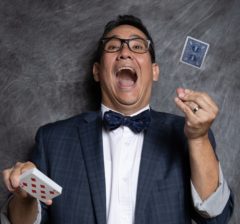In my hotel room last night I made a ton of color changing card gaffs. I made them with latex and with elastic. I made them flip vertically and horizontally. Here’s what I learned, I prefer using the ones with the seam the goes across the length of the card. I also prefer them to have the elastic thread, so basically I’m using the “Hondo” style gaffed card.

I think trying a lot of different ways to make the gimmick will let you know for sure which is right for you. Sometimes what’s available to buy isn’t quite right for what you are doing. For example my hands prefer the gimmick to be latex and with the flap’s seam going across the short sideof the card. However how the gimmick is used an elastic thread gimmick with the seam running the long way visually looks better.
It’s important to know why you use a gimmick over another one or variation of it. If I stuck to what feels good in my hand, what actually looks better to the audience would be lost. In theory, it’s all for the audience!


